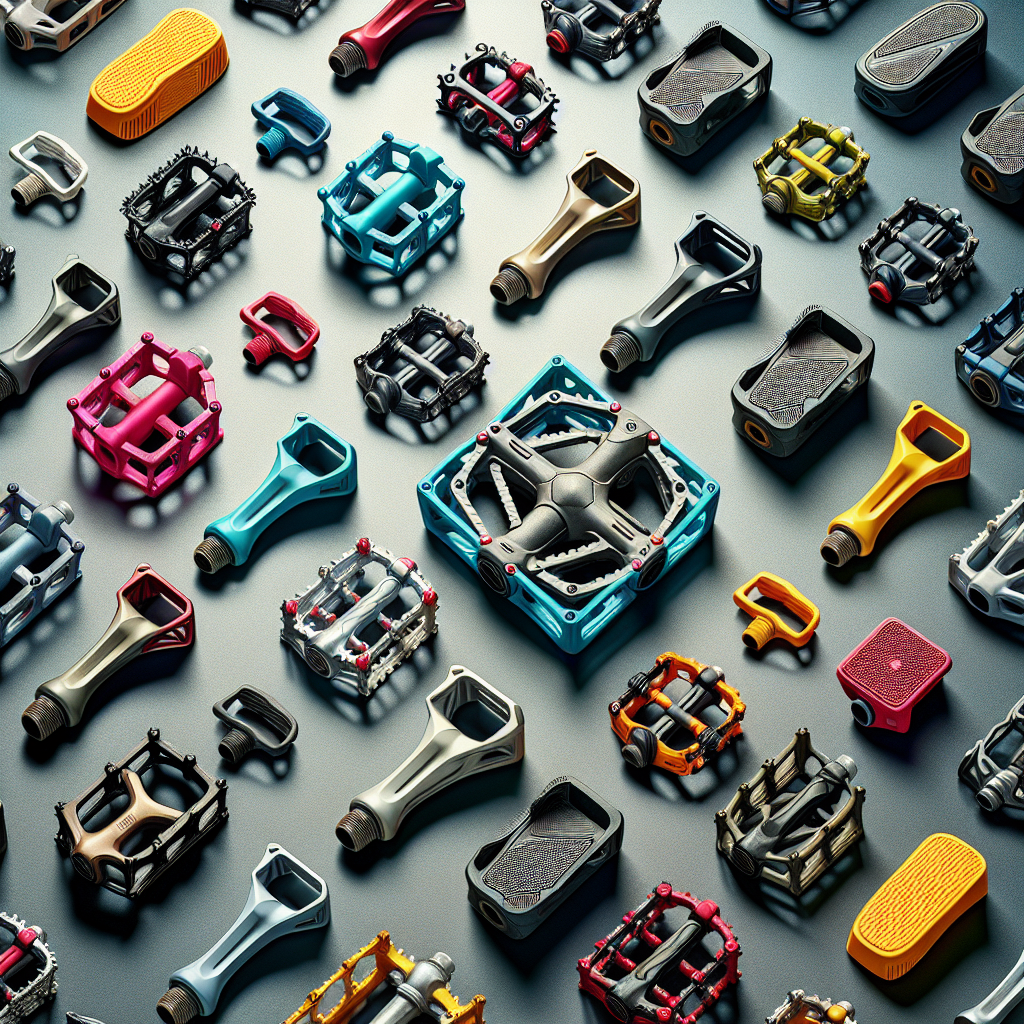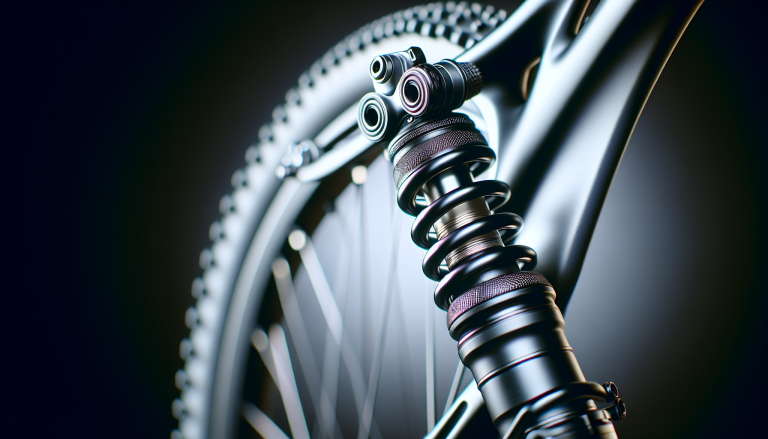Imagine gliding through the open road, the wind caressing your face as your bike effortlessly takes you to new destinations. But have you ever wondered what makes your cycling experience even more enjoyable? The answer lies in the pedals. Yes, those small yet crucial components that connect your feet to the bike. In this article, we will explore the fascinating world of cycling pedals. From platform pedals for casual rides to clipless pedals for the more adventurous, we will uncover the various types of pedals and help you choose the perfect pair to enhance your cycling journey. Get ready to pedal your way to newfound knowledge!
Table of Contents
ToggleFlat Pedals
Flat pedals, also known as platform pedals, are the most basic and common type of pedals used in cycling. They provide a flat surface for your feet to rest on and are typically made of durable materials such as aluminum or composite materials.
Standard Flat Pedals
Standard flat pedals are the simplest and most straightforward pedals available. They feature a flat platform with no additional features or attachments. These pedals are typically used for casual riding or commuting, where the rider does not need to be securely attached to the pedals.
Toe Clip Pedals
Toe clip pedals, also known as toe cage pedals, are designed to provide a more secure pedaling experience. They consist of a flat platform with an added cage or clip at the front. The rider can slide their foot into the cage and secure it with a strap, providing extra stability and control. Toe clip pedals are commonly used in touring, commuting, and even some mountain biking disciplines.
Clipless Pedals
Clipless pedals, despite their misleading name, are actually pedals that require special cycling shoes with cleats to attach to them. Clipless pedals provide a locking mechanism that securely connects the shoe to the pedal, allowing for more efficient pedal strokes and improved power transfer.
Platform Pedals
Platform pedals, also known as flat pedals, are ideal for riders who prefer to ride without being attached to the pedals. They provide a large, stable surface for the rider’s foot to rest on. Platform pedals are versatile and suitable for various cycling disciplines.
Traditional Platform Pedals
Traditional platform pedals are the most basic and common type of platform pedals. They offer a flat surface with no additional features. These pedals are ideal for recreational riders and beginners who prefer simplicity and do not require a secure attachment.
BMX Pedals
BMX pedals are designed specifically for BMX riders. They are typically made of tough, durable materials to withstand the impact and abuse of BMX riding. These pedals often have metal pins or ridges on the surface to provide extra grip and prevent the rider’s feet from slipping off during jumps and tricks.
Metal Platform Pedals
Metal platform pedals are known for their durability and strength. They are made of materials such as aluminum or steel, making them suitable for riders who engage in aggressive riding styles or ride in rough terrains. Metal platform pedals often come with features like replaceable pins for enhanced grip and customization.
Plastic Platform Pedals
Plastic platform pedals, also known as composite pedals, are lightweight and can be more affordable compared to metal platform pedals. They are made from durable plastic materials, such as nylon, and can provide a good balance between weight and strength. Plastic platform pedals often have molded pins or ridges for added grip.
Traction Pedals
Traction pedals are a specialized type of platform pedals designed to provide maximum grip in challenging conditions. They typically feature larger surface areas with aggressive pins or spikes that dig into the sole of the shoe, offering superior traction and preventing slippage on wet or muddy terrain. Traction pedals are commonly used in downhill and enduro mountain biking.
Cage Pedals
Cage pedals, also known as toe clip pedals, combine the design of flat pedals with added cages or clips to secure the rider’s feet. These pedals provide a middle ground between the stability of clipless pedals and the freedom of flat pedals.
Toe Clip Cage Pedals
Toe clip cage pedals feature a toe cage attached to the front of the pedal platform. The rider can slide their foot into the cage and secure it with straps, providing a secure connection without the need for specific cycling shoes. Toe clip cage pedals are often used by commuters, touring cyclists, and riders who want some added security without committing to clipless pedals.
Half Clips Cage Pedals
Half clips cage pedals are similar to toe clip cage pedals, but they only cover half of the rider’s foot. Half clips provide a partial enclosure for the front part of the foot, allowing for easy entry and exit while still providing some added stability and control.
Clipless Pedals
Clipless pedals are a popular choice among experienced cyclists and competitive riders. Contrary to their name, clipless pedals require special cycling shoes with cleats that attach to the pedal, providing a secure connection.
What are Clipless Pedals?
Clipless pedals are a modern pedal system that allows the rider’s feet to be attached to the pedals using special cycling shoes and cleats. Unlike toe clip pedals or cage pedals, clipless pedals do not have physical clips or cages on the pedal itself. Instead, the cleats on the bottom of the cycling shoes lock into the pedal mechanism, creating a secure connection.
Advantages of Clipless Pedals
Clipless pedals offer several advantages for cyclists. First and foremost, they provide a more efficient and powerful pedal stroke. The rider can exert force in both the downstroke and upstroke, maximizing power transfer to the pedals. This increased efficiency can lead to improved speed and less fatigue during long rides or races.
Additionally, clipless pedals provide a more secure connection between the foot and the pedal. This can enhance control and stability, especially during aggressive riding, such as climbing steep hills or sprinting. The rider’s feet remain firmly attached to the pedals, reducing the risk of slipping off during sudden movements or rough terrains.
Another benefit of clipless pedals is the ability to fine-tune the position of the foot. Cleats can be adjusted to align with the rider’s natural pedaling motion, reducing the risk of discomfort or injury. The ability to customize the cleat position can also help improve pedaling efficiency and reduce the risk of joint stress.
Disadvantages of Clipless Pedals
Despite their advantages, clipless pedals may not be suitable for all cyclists. One of the main drawbacks is the need for compatible cycling shoes and cleats. This additional requirement adds to the overall cost of the pedal system. Moreover, the specialized footwear may be less comfortable for walking or performing off-bike activities.
There is also a learning curve associated with using clipless pedals. New users may find it challenging to quickly detach their feet from the pedals, which can lead to falls or accidents. However, with practice and familiarity, this becomes less of an issue.
Clipless pedals also require regular maintenance and adjustment to ensure optimal performance. Cleats may wear down over time and need to be replaced, and the pedal mechanism itself may require occasional lubrication.
Difference Between Clipless and Toe Clip Pedals
The main difference between clipless pedals and toe clip pedals, also known as toe cage pedals, lies in how the foot is attached to the pedal. Clipless pedals require special cycling shoes with cleats that lock into the pedal mechanism. In contrast, toe clip pedals use a cage or clip attached to the pedal, allowing the rider to secure their foot with a strap.
While clipless pedals provide a more secure and efficient connection, toe clip pedals offer a greater degree of freedom and versatility. With toe clip pedals, riders can wear regular shoes and adjust the tightness of the straps to their preference. Clipless pedals, on the other hand, require specific cycling shoes and a compatible pedal system.
Different Types of Clipless Pedal Systems
There are several types of clipless pedal systems available, each with its own design and mechanism of engagement and release. Some of the most common clipless pedal systems for road cycling include:
SPD-SL Pedals
SPD-SL pedals, made by Shimano, are a popular choice among road cyclists. They feature a wide cleat design for better power transfer and stability. The engagement and release mechanism is located on the pedal itself, making it easier to clip in and out.
Look Keo Pedals
Look Keo pedals are another popular option, favored by many professional cyclists. They feature a lightweight and aerodynamic design, with a large cleat surface for optimal power transfer. Keo pedals have a secure engagement system and are known for their durability.
Speedplay Pedals
Speedplay pedals have a unique design that allows for a dual-sided entry, making it easier for riders to clip in quickly. The cleat design is small and lightweight, which can be advantageous for weight-conscious cyclists. Speedplay pedals offer customizable float and release tension options.
Time Pedals
Time pedals are known for their reliability and solid construction. They feature a patented ATAC (Auto Tension Adjust Concept) engagement system, which provides consistent and secure clipping in and out. Time pedals offer adjustable release tension and a wide range of float options.
Road Bike Pedals
Road bike pedals are designed specifically for road cycling, prioritizing lightweight construction, aerodynamics, and efficient power transfer. There are different types of road bike pedals to suit various riding needs and preferences.
SPD-SL Pedals
SPD-SL pedals, as mentioned previously, are a popular choice for road cycling. These pedals have a wide platform to distribute pedaling force more evenly and efficiently. The large cleat system provides a secure connection between the shoe and the pedal, allowing for enhanced power transfer and stability.
Look Keo Pedals
Look Keo pedals, also discussed earlier, are widely used by both professional and amateur road cyclists. These pedals have a lightweight and streamlined design that minimizes drag and maximizes pedaling efficiency. With a wide cleat surface area, Look Keo pedals offer excellent power transfer and a secure connection.
Speedplay Pedals
Speedplay pedals, previously mentioned, are also commonly used for road cycling. Their dual-sided entry design allows for quick and easy engagement, making them a popular choice for competitive road cyclists. Speedplay pedals offer adjustable float and release tension, allowing riders to customize their pedal setup.
Time Pedals
Time pedals, as discussed earlier, are known for their reliability and consistent performance. The ATAC engagement system provides a secure and solid connection between the shoe and the pedal. Time pedals offer adjustable release tension and are available in various models to suit different road cycling disciplines.
Mountain Bike Pedals
Mountain bike pedals are designed to withstand the demands of off-road riding, providing a secure and stable connection between the rider and the bike. There are different types of mountain bike pedals to accommodate various styles of mountain biking.
Flat Mountain Bike Pedals
Flat mountain bike pedals, also known as platform pedals, are a popular choice among mountain bikers who prefer not to use clipless pedals. These pedals provide a large, flat surface for the rider’s foot to rest on, increasing stability and allowing for easy foot repositioning. Flat pedals are commonly used in downhill, freeride, and trail riding.
Trail Pedals
Trail pedals are a type of clipless mountain bike pedals that strike a balance between the freedom of flat pedals and the efficiency of clipless pedals. They provide a secure connection between the rider’s shoe and the pedal but with a mechanism that allows for easier entry and release. Trail pedals are suitable for various mountain biking disciplines and are often used by cross-country and trail riders.
Enduro Pedals
Enduro pedals, as the name suggests, are designed for enduro mountain biking, which involves long and challenging descents and climbs. These pedals typically feature a larger platform for added stability and support during aggressive riding. Enduro pedals often have additional features like metal pins or spikes for enhanced grip and durability.
Downhill Pedals
Downhill pedals are specifically designed for downhill mountain biking, where speed and control are paramount. These pedals have a wider and more robust construction to withstand the impact and abuse of downhill riding. Downhill pedals often feature metal pins or ridges for maximum grip and a secure connection with the rider’s shoes.
Touring Pedals
Touring pedals are designed for cyclists who embark on long-distance journeys or bike tours, where comfort and versatility are crucial. These pedals aim to strike a balance between efficient pedaling and added convenience.
Combination Pedals
Combination pedals, also known as hybrid pedals or dual-sided pedals, offer the option of using either flat pedals or clipless pedals. One side of the pedal features a flat platform, while the other side has a clipless mechanism compatible with cycling shoes. Combination pedals are ideal for cyclists who want the flexibility to switch between clipless and flat pedals as needed during a tour.
Platform Clipless Pedals
Platform clipless pedals combine the advantages of both flat pedals and clipless pedals. They have a large platform similar to flat pedals but also feature a clipless mechanism that allows for a secure connection with compatible cycling shoes. Platform clipless pedals provide the convenience and stability of flat pedals when unclipped and the power transfer benefits of clipless pedals when engaged.
Half Clips with Straps
Half clips with straps are a variation of toe clips that are commonly used in touring. Instead of a full toe cage, these pedals have a smaller clip that only covers the front part of the foot. The clip keeps the foot in place, while the straps provide additional security and control. Half clips with straps are a less restrictive option compared to full toe clip pedals and are popular among touring cyclists.
City/Commuting Pedals
City or commuting pedals are designed to provide comfort, durability, and practicality for cyclists who primarily use their bikes for commuting or urban riding.
Pedals with Integrated Lights
Pedals with integrated lights are a creative solution that adds an extra level of safety for commuting cyclists. These pedals have built-in LED lights that provide visibility to other road users. The lights are often powered by small batteries or are rechargeable. Pedals with integrated lights are a convenient way to enhance visibility without the need for additional mounted lights or accessories.
Pedals with Toe Cages
Pedals with toe cages, also known as toe clip pedals, are a favored choice for commuting cyclists. These pedals feature a cage at the front, allowing the rider to slide their foot in and secure it with a strap. Toe cages provide some added security and control without the need for specific cycling shoes. They are ideal for urban riding where quick stops and starts are frequent.
Platform Pedals
Platform pedals, as mentioned earlier, are a versatile option for city or commuting cycling. They provide a flat surface for the rider’s foot to rest on and are compatible with regular shoes. Platform pedals offer the convenience of easily getting on and off the bike without the need to change footwear. They are popular for short, leisurely rides or commutes where speed and efficiency are not the primary concern.
Gravel/Cyclocross Pedals
Gravel and cyclocross cycling involve riding on a mixture of paved roads, gravel paths, and off-road terrain. Pedals for these disciplines need to offer a balance between efficiency and off-road capability.
SPD Pedals
SPD pedals, made by Shimano, are a popular choice for gravel and cyclocross riding. These pedals feature a small, recessed cleat system that is compatible with SPD-compatible cycling shoes. The recessed cleats allow for easier walking or running off the bike, making SPD pedals ideal for mixed terrain riding. SPD pedals offer a good compromise between clipless efficiency and practicality.
Crank Brothers Pedals
Crank Brothers pedals are known for their mud-shedding design, making them suitable for gravel and cyclocross riding where mud and debris can accumulate. These pedals feature a four-sided entry system, allowing for easy engagement from various angles. Crank Brothers pedals also provide a minimalistic design and a wide range of float options.
Time Pedals
Time pedals, previously discussed, are also a popular choice for gravel and cyclocross riding. Their ATAC engagement system and robust construction make them suitable for off-road conditions. Time pedals offer adjustable release tension and a variety of float options to accommodate different riding styles.
Track Bike Pedals
Track bike pedals are designed specifically for track cycling, which takes place on a velodrome. The pedals used in this discipline prioritize power transfer and efficiency.
Cage Pedals
Cage pedals, also known as toe clip pedals, are commonly used in track cycling. These pedals feature a toe cage attached to the front of the pedal platform. The rider can slide their foot into the cage and secure it with straps, providing a secure connection without the need for clipless systems. Cage pedals allow riders to generate power throughout the entire pedal stroke and are favored by track cyclists for their simplicity and cost-effectiveness.
Clipless Pedals
Clipless pedals are also used in track cycling, particularly in competitive events. While cage pedals provide a secure connection, clipless pedals offer even greater power transfer and control. Track cyclists using clipless pedals wear specific cycling shoes with compatible cleats that engage with the pedal mechanism. The clipless system allows for efficient pedaling and rapid acceleration, crucial in track cycling.
In conclusion, there are various types of pedals available for cycling, catering to different riding styles and disciplines. From flat pedals to clipless pedals, each type has its own advantages and considerations. Choosing the right pedals for your cycling needs is essential for comfort, efficiency, and overall enjoyment on the bike. Whether you prefer the freedom of flat pedals, the secure attachment of clipless pedals, or the versatility of combination or cage pedals, the right choice can enhance your cycling experience. Consider your riding preferences, goals, and terrain to make an informed decision when selecting pedals for your bike.







